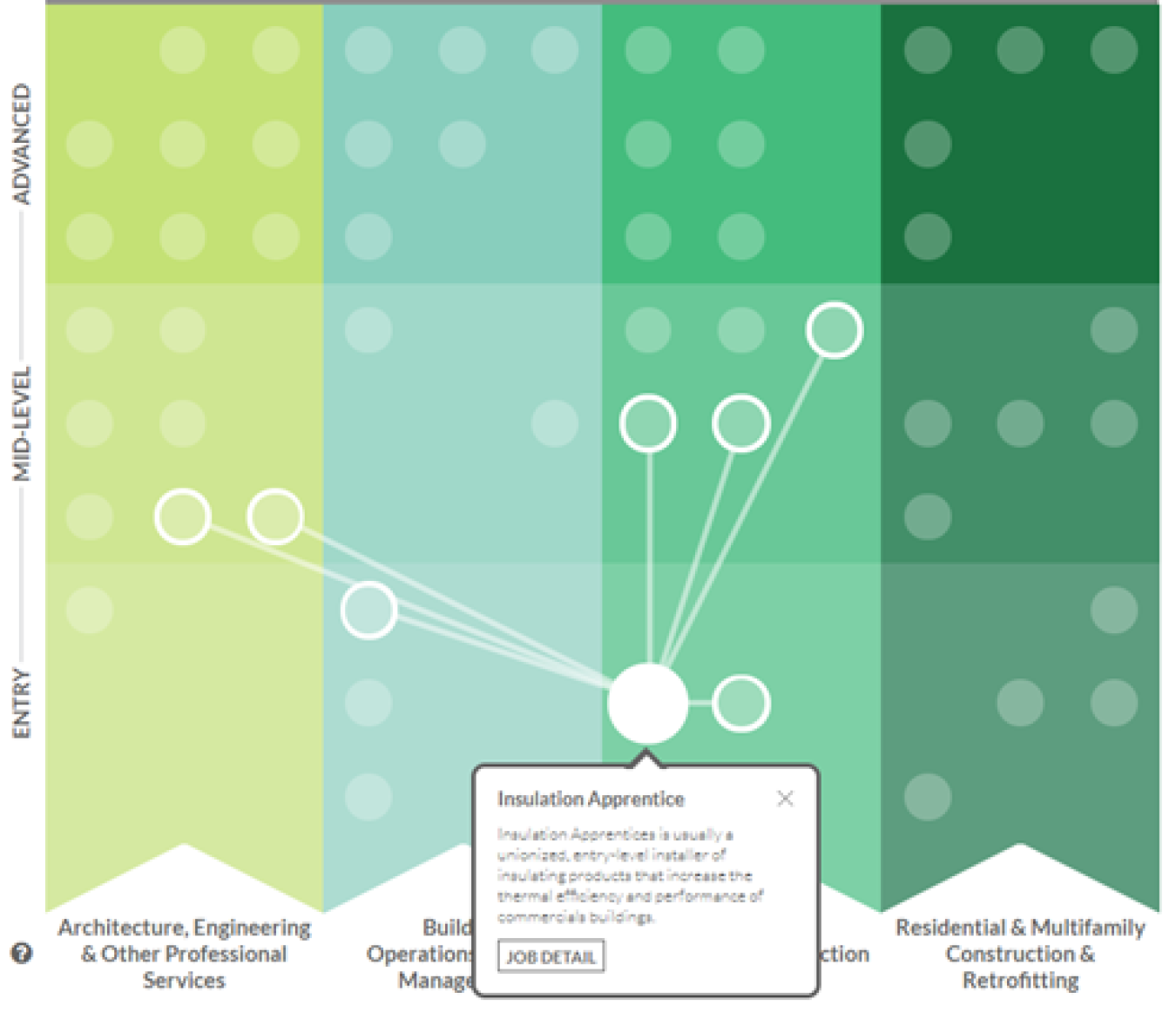A new recruiting tool funded by the Building Technologies Office offers job seekers hundreds of options to obtain and advance careers in the energy-efficient buildings industry.
May 6, 2021
The career map shows multiple opportunities for an insulation apprentice, including construction foreperson, insulation mechanic, and building maintenance technician.
A new recruiting tool funded by the Building Technologies Office offers job seekers hundreds of options to obtain and advance careers in the energy-efficient buildings industry. As part of a nationwide effort to recruit an energy-efficiency workforce focused on constructing, retrofitting, and maintaining healthy and energy-efficient buildings, BTO partnered with the Interstate Renewable Energy Council and other industry groups to develop the Green Buildings Career Map.
This interactive tool helps young people and those transitioning careers to “map” their paths to 55 energy-efficiency careers, including 32 “new-collar” jobs, such as home energy assessor, healthy home evaluator, and building engineer, that do not require four-year degrees. Each job description includes an expected salary range and required skills, along with multiple opportunities for next steps, either within the same sector or transitioning between sectors.
In-demand careers that support efficient and high-performing buildings exist across the entire buildings supply chain—from the design and development of efficient technologies that comprise energy-efficient buildings, to their construction, maintenance, management, and financing. For example, energy-efficiency-focused jobs grew twice as fast as the national rate,1 reaching nearly 2.4 million workers by the end of 2019.2 Despite this growth, recent research shows that many prospective job seekers encounter barriers to entering the building efficiency workforce, including confusing pathways to identify these careers.3 The Green Buildings Career Map helps streamline this process for job seekers. In addition to providing information to job seekers, the map is intended to help career and guidance counselors, employers, policymakers, and educators understand the diverse and rewarding occupations across the industry.
How Does the Green Buildings Career Map Work?
Each dot on the map represents a specific energy-efficient building career, and leads to a page with detailed career information, including which positions the job could lead to in the future. A few minutes clicking through the career map reveals the many career pathways within the energy-efficient building industry. Clicking on the "Insulation Apprentice" dot shows this as an entry-level career in the “Commercial & Institutional Construction & Retrofitting” sector. The job detail page shows this position has an hourly wage range of $15-43 per hour and requires a high school diploma or equivalent for education and training, and no required work experience. The map also reveals seven potential jobs that an insulation apprentice could pursue next on their career path, including building maintenance technician, construction foreperson, and insulation mechanic.

By making buildings more energy efficient, these workers are helping the world reverse some of its most vexing problems one building at a time. Better-performing buildings make our homes and communities better places to live and work, and Americans across construction and manufacturing sectors are building a better future for all of us.
Acting Assistant Secretary Kelly Speakes-Backman of DOE’s Office of Energy Efficiency and Renewable Energy says that expanding and diversifying the efficiency workforce is critical for achieving the Department’s ambitious climate goals. “Our goals for energy savings and cleaner, healthier air are commensurate with our goals for a diverse, skilled, and well-compensated workforce,” Speakes-Backman says. “We must ensure that Americans understand how valuable these workers are for our future, and that there are good careers available to build this energy economy.”
DOE’s Office of Energy Jobs aims to ensure that the “new-collar” careers offer family-sustaining wages with health care and worker protections. Learn more about DOE’s efforts to support America’s buildings workforce so they can benefit from—and see their future in—the efficient energy revolution.
.....
1 E4TheFuture, Energy Efficiency Jobs in America, November 2020, https://e4thefuture.org/wp-content/uploads/2020/11/EE_Jobs_America_2020.pdf.
2 National Association of State Energy Officials (NASEO) and Energy Futures Initiative (EFI), 2020 U.S. Energy and Employment Report, November 2020.
3 Truit, Sarah, Juliana Williams, and Madeline Salzman. Building the Efficiency Workforce, August 2020, https://www.nrel.gov/docs/fy20osti/75497.pdf.

